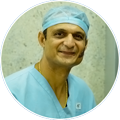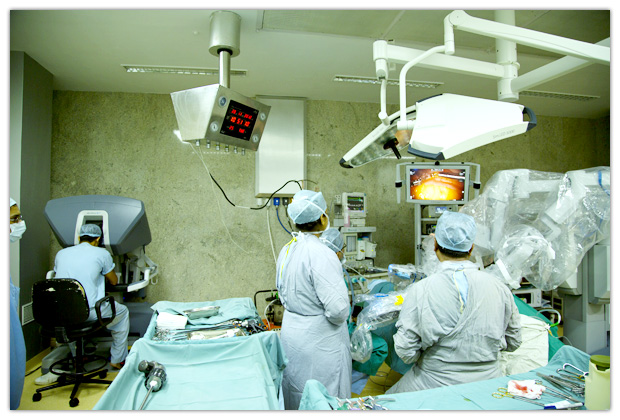
DR. VINAY MAHENDRA
Senior Robotic Surgeon in Kolkata, India
MS. Mch (Urol.), DBN (Urol.), FRCS (Glasg.) FRCS (Urol.) Senior Consultant Urologist
Laparoscopic And Robotic Urological Surgeon and Renal Transplant Surgeon
![]()
FOR APPOINTMENT CALL SECRETARY
+91 9830216715 (Secretary Amit Roychowdhury : 11:00 A.M. - 4:00 P.M.)
+91 9830492572 (Secretary, Dalia Chatterjee : 11:00 A.M. - 4:00 P.M.)
WHAT IS ROBOTIC SURGERY?
The robotic surgery is the latest and most advanced technology to perform complex and difficult surgeries in a minimally invasive way with ease thereby translating into better clinical outcome.
The robotic system comprises of two parts
1. Robotic tower
2. Master computer console
3. Robotic Tower: It has one arm for the attachment of camera and three arms to attach the robotic instruments. Tiny holes are made in the patient’s abdomen and robotic camera and instruments are placed inside through them. These are attachec to the robotic tower (called as “Docking of the Robot”).
4. Master computer console is the place where the surgeon sits and gets a magnified 3D image of the patient’s abdomen and controls the robotic instruments with the hand controls in the console.
Hence, the robot does not operate but is a tool in surgeon’s hands to perform complex surgeries safely and efficiently.
Benefits Of Robotic Surgery:
1. The da Vinci Camera
Standard laparoscopic surgery utilizes one single camera and limits the surgeon’s vision to 2-D view similar to watching a television. The da Vinci camera consists of TWO high resolutionfibreoptic cameras. They produce a true 3-D color picture to the surgeon sitting on the master console. Magnification of upto 15 times can be achieved with these cameras. This magnified 3-D image gives an excellent visualization to the surgeon thereby making the surgery safer and more efficient translating into better results for the patient.

2. The da Vinci Surgical Instruments
Although they look a bit similar to standard laparoscopic instruments the robotic instruments have additional advantage of being articulated. This allows the instruments to open, close and fully turn and twist mimicking the movement of human wrist and fingers. This enables the robotic instruments to have 7 degree of freedom compared to only two degree of freedom in standard laparoscopic instruments. This enables the surgeon to do precise cutting exactly at the intended place thus minimizing inadvertent injury to neighbouring structures. This also allows the surgeon to perform complex suturing for reconstruction which translates into superior postoperative results.
Standard laparoscopic instruments are manipulated in a counterintuitive waywhile the robotic instruments operate in an intuitive way. The robotic system also allows the surgeon to scale his movements which is not possible in standard laparoscopy. The system also eliminates surgeon fatigue tremors.
3. Minimal Blood Loss with Robotic Surgery
The enhanced 3-D vision and advanced robotic instruments enable the surgeon to see even small blood vessels and control them even in areas which are not easily accessible with standard laparoscopy.
4. Postoperative Recovery
Postoperative recovery is fast and most patients go home in 2 to 3 days after major robotic surgery and are able to get back to work in 1 to 2 weeks post discharge
5. Better vision and better instruments
Better vision and better instruments help in better cancer clearance and thus reduce the need for additional treatment in the form of chemotherapy and radiotherapy. This increases the cure rates and also reduces the cost and side effects of additional treatment.
Urological Procedures performed with Robot:
• Robotic Radical Prostatectomy – for prostate cancer
• Robotic partial Nephrectomy – kidney saving surgery for kidney cancer
• Robotic Radical nephrectomy – for large kidney cancers
• Robotic Donor Nephrectomy – for transplant
• Robotic Partial / Radical Cystectomy – for bladder cancer
• Robotic Pyeloplasty – for kidney obstruction (Hydronephrosis)
• Complex urinary Stone surgery
• Ureteric reimplantation
• Repair of Vesicovaginal fistula
UROLOGICAL APPLICATION
DR. VINAY MAHENDRA
MS. Mch (Urol.), DBN (Urol.), FRCS (Glasg.) FRCS (Urol.) Senior Consultant Urologist Laparoscopic And Robotic Urological Surgeon and Renal Transplant Surgeon
ADDRESS:
Apollo Multispeciality Hospitals
58, Canal Circular Road, Kolkata - 700054, West Bengal. India.
FOR APPOINTMENT CALL SECRETARY :
+91 9830216715
(Secretary Amit Roychowdhury : 11:00 A.M. - 4:00 P.M.)
+91 9830492572
(Secretary, Dalia Chatterjee : 11:00 A.M. - 4:00 P.M.)
E-MAIL :
drmahendraappointments@roboticsurgerykolkata.com
WEBSITE :
www.roboticsurgerykolkata.com
POWERED BY :
www.calcuttayellowpages.com